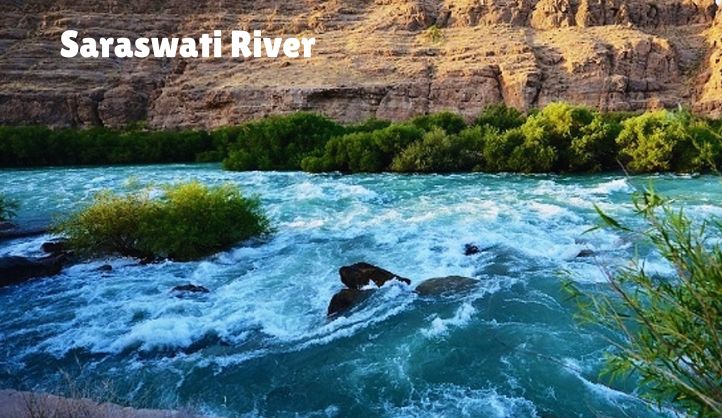The Saraswati River is a mystical and sacred river mentioned in ancient Hindu scriptures, believed to flow in the region of Uttarakhand in India. While its exact course remains a subject of debate and legend, the Saraswati River is considered one of the three major rivers of the Triveni Sangam, where it is said to meet the Ganges and Yamuna at Prayagraj (Allahabad). Unlike the Ganga and Yamuna, the Saraswati is often referred to as an “invisible river” due to its mysterious nature and lack of an identifiable physical presence in contemporary geography. However, in Uttarakhand, there are some locations where the river is believed to exist in a tangible form, most notably in the town of Mana near Badrinath, where a small stream named the Saraswati emerges before merging with the Alaknanda River.
Geographical Overview of the Saraswati River
The Saraswati River of Uttarakhand, though significantly smaller and less voluminous than the legendary river described in ancient texts, is found in the Chamoli district, specifically in the pilgrimage town of Mana near Badrinath. Originating from a glacier near the Mana Pass, at an elevation of about 3,200 meters (10,500 feet), this river flows through the rocky terrains and lush meadows of the Garhwal Himalayas, creating a picturesque and spiritually significant landscape.
The Saraswati merges with the Alaknanda River, a major tributary of the Ganges, at Keshav Prayag, located just a short distance from the Mana village. This confluence is considered highly auspicious, with many pilgrims visiting the site to offer prayers and seek blessings. The river is not long, but its flow through this remote and sacred area adds to its mystical aura.
Mythological Significance of the Saraswati River
The Saraswati River holds a profound place in Hindu mythology. It is believed to be one of the three most sacred rivers in Hindu tradition, alongside the Ganga (Ganges) and the Yamuna. The Saraswati is often associated with Saraswati, the goddess of wisdom, learning, and arts, which adds a layer of divine significance to its waters. Ancient scriptures, such as the Rigveda, mention the Saraswati as a mighty river that flowed from the Himalayas to the Arabian Sea, nourishing civilizations along its banks.
The Saraswati River in Uttarakhand is often considered the last visible trace of this once-mighty river. Many believe that after flowing through the Mana region, the Saraswati River mysteriously disappears underground, only to emerge again at Triveni Sangam in Allahabad (Prayagraj), where it is said to meet the Ganga and Yamuna. This belief makes the river a symbol of continuity, connecting the past and the present.
Spiritual and Cultural Importance
The Saraswati River in Uttarakhand holds a special place in the hearts of pilgrims and devotees who visit Badrinath, one of the Char Dham (four sacred abodes) in Hinduism. The river’s proximity to Badrinath enhances its spiritual significance. According to local lore, the Saraswati River guards the entrance to the mythical cave known as Vyas Gufa, where the sage Ved Vyasa is believed to have composed the Mahabharata and the Puranas. Pilgrims often visit this cave and pay homage to the river, seeking divine inspiration and knowledge.
Another popular belief is that bathing in the Saraswati River, or simply touching its waters, can purify one’s sins and provide spiritual liberation. Many pilgrims take a ritual bath in the river before proceeding to the Badrinath Temple, believing that the sacred waters cleanse the body and soul, preparing them for the darshan (sight) of Lord Vishnu.
The Lost River: Historical and Scientific Perspectives
The Saraswati River has long intrigued historians, archaeologists, and scientists. While mythological texts describe it as a major river of ancient India, visible remnants of the Saraswati have largely eluded modern discovery. Many historians suggest that the Saraswati River dried up or disappeared due to tectonic shifts, climate changes, and the gradual desertification of the region around 2000 BCE.
In Uttarakhand, however, the river remains a physical reality, albeit a small one. The discovery of a small stream named Saraswati in the Mana region has sparked interest among geologists and researchers. Some suggest that this river could be a vestigial remnant of the ancient Saraswati River, whose waters may still flow underground, only surfacing at specific points like the one near Mana village.
Pilgrimage and Tourism in Mana Village
Mana, the last village on the Indian side of the Indo-Tibetan border, is a popular destination for tourists and pilgrims. The village is situated just 3 kilometers from the Badrinath Temple, and the Saraswati River is one of its prime attractions. Visitors often trek to the point where the river gushes out from under a massive rock, known as the Bhim Pul. According to legend, the Pandava brother Bhima placed this rock over the Saraswati River to help Draupadi cross it during their journey to the heavens.
The trek to the source of the Saraswati River provides an excellent opportunity for adventure enthusiasts and spiritual seekers alike. The breathtaking views of the Himalayas, combined with the serene ambiance of the river, offer a unique experience that blends natural beauty with deep spirituality..
The Disappearance and Reappearance of the Saraswati River
The Saraswati River’s disappearance underground has been a topic of fascination for centuries. Local traditions and beliefs suggest that after emerging in Uttarakhand, the Saraswati River flows beneath the ground, only to surface again at various holy sites across India. The notion of a subterranean river adds an element of mystery and intrigue, making the river a subject of numerous folk tales and legends.
Scientists and geologists have attempted to trace the underground flow of the Saraswati River using advanced technology such as satellite imagery and ground-penetrating radar. Some studies suggest that the river might flow beneath the earth, following a path similar to the ancient Saraswati described in Vedic texts. However, conclusive evidence remains elusive, adding to the river’s enigmatic status.
Saraswati River in Local Culture and Folklore
The Saraswati River holds a cherished place in local culture and folklore. Stories of its divine origin, its mystical disappearance, and its role in epic tales like the Mahabharata are passed down from generation to generation. For the people of Uttarakhand, the river is not just a waterway but a living symbol of their cultural and spiritual heritage.
Festivals and rituals are often centered around the Saraswati River, with local communities organizing special prayers, river-worship ceremonies, and storytelling sessions that celebrate its mythological significance. The river is also a source of livelihood for many, providing water for agriculture, livestock, and daily needs.
Saraswati River in Mana Village
Mana, the last village on the Indian side of the Indo-Tibetan border, is located about 3 kilometers from the pilgrimage town of Badrinath. It is here that the Saraswati River is said to be visible as a small stream. The river emerges from a glacier near Mana Pass and flows through the village before joining the Alaknanda River at a confluence called Keshav Prayag.
The river’s presence is marked by a small bridge, known as the “Bheem Pul,” which is believed to have been constructed by Bheema, one of the Pandava brothers from the Mahabharata, by placing a massive stone slab across the river to allow his wife, Draupadi, to cross safely. This site is a popular tourist attraction, drawing visitors who wish to see the sacred waters of the Saraswati and experience the serenity of the Himalayan landscape.
Nearby Places to Visit
Badrinath Temple: One of the most important pilgrimage sites for Hindus, Badrinath Temple is dedicated to Lord Vishnu. Located just a few kilometers from Mana village, it is part of the Char Dham Yatra and is set against the stunning backdrop of the Neelkanth Peak. The temple attracts thousands of pilgrims each year and offers a serene spiritual experience amidst the grandeur of the Himalayas.
Vasudhara Falls: Located around 5 kilometers from Mana village, Vasudhara Falls is a scenic waterfall that cascades down from a height of about 400 feet. The trek to the falls is moderately challenging but offers breathtaking views of the surrounding mountains and valleys. The waterfall is considered sacred and is believed to cleanse those who stand under its flow of all sins.
Satopanth Lake: Located about 25 kilometers from Mana village, Satopanth Lake is a glacial lake situated at an altitude of around 4,600 meters. The trek to Satopanth is challenging and requires proper acclimatization, but it offers stunning views of the surrounding peaks and glaciers. The lake is considered sacred and is associated with Lord Vishnu.
Swargarohini: Swargarohini, also known as the “Stairway to Heaven,” is a group of four peaks located in the western Garhwal Himalayas. According to Hindu mythology, this is the route taken by the Pandavas on their journey to heaven. The trek to Swargarohini is challenging and is best suited for experienced trekkers. The journey is considered spiritually significant, and the views of the surrounding peaks are truly breathtaking.
Mana Pass: Mana Pass is one of the highest motorable roads in the world, located near Mana village at an altitude of 5,545 meters. It serves as a gateway to Tibet and offers panoramic views of the surrounding Himalayan ranges. Due to its remote location and extreme weather conditions, the pass is only accessible during certain months of the year, but it remains a popular destination for adventure enthusiasts.
Joshimath: About 44 kilometers from Badrinath, Joshimath is a significant town in the Chamoli district of Uttarakhand. It is known for its ancient temples, including the Narasimha Temple and the Shankaracharya Math, and serves as the winter seat of Lord Badrinath. Joshimath is also the base for the Auli ski resort, which is a popular destination for skiing and other winter sports.
Auli: Auli, located near Joshimath, is a popular hill station and ski resort known for its beautiful snow-covered slopes. It offers a range of activities such as skiing, snowboarding, and trekking, making it a favorite destination for adventure seekers. The Auli Ropeway, one of the longest cable cars in Asia, provides stunning views of the Himalayan peaks, including Nanda Devi, Trishul, and Dronagiri.
FAQs about the Saraswati River in Uttarakhand
1. What is the significance of the Saraswati River in Hindu mythology?
The Saraswati River is considered sacred in Hindu mythology and is often personified as the goddess Saraswati, the deity of wisdom, knowledge, music, and arts. It is mentioned in various Vedic texts and is believed to have played a vital role in the development of ancient Indian civilization. Although the river is considered “invisible” in its current form, it holds immense spiritual importance.
2. Where can one see the Saraswati River in Uttarakhand?
The Saraswati River can be seen at Mana village near Badrinath in Uttarakhand. Here, it appears as a small stream originating from a glacier and flowing through the village before merging with the Alaknanda River. The river’s presence is marked by the “Bheem Pul,” a stone bridge believed to have been built by the Pandava prince Bheema.
3. How can one reach Mana village and the Saraswati River?
Mana village is located about 3 kilometers from Badrinath, which is accessible by road from various parts of Uttarakhand. The nearest airport is Jolly Grant Airport in Dehradun, around 317 kilometers away, and the nearest railway station is Rishikesh, about 295 kilometers away. From Badrinath, one can easily reach Mana by hiring a local taxi or trekking on foot.
4. What are some nearby places to visit along with the Saraswati River in Uttarakhand?
Along with the Saraswati River, visitors can explore several nearby attractions, including Badrinath Temple, Vasudhara Falls, Vyas Gufa, Ganesha Gufa, Satopanth Lake, Swargarohini, Mana Pass, Joshimath, Auli, and Niti Village. Each of these places offers a unique blend of natural beauty, spirituality, and adventure.
5. Is there any scientific evidence of the Saraswati River’s existence in Uttarakhand?
While there is no definitive scientific evidence tracing the complete course of the Saraswati River in Uttarakhand, geological studies and satellite imagery suggest that the river may have existed in ancient times. The river’s disappearance is often attributed to natural changes





